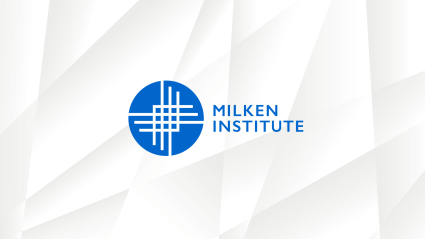Meena Seshamani, M.D., Ph.D.
Deputy Administrator and Director of the Center for Medicare
Centers for Medicare & Medicaid Services
US Department of Health and Human Services
Baltimore, Maryland 21244
Dear Dr. Seshamani,
The FasterCures team at the Milken Institute is honored to provide its expert response to the Request for Comments on the Medicare Drug Price Negotiation Program: Draft Guidance, Implementation of Sections 1191–1198 of the Social Security Act for Initial Price Applicability Year 2027 and Manufacturer Effectuation of the Maximum Fair Price (MFP) in 2026 and 2027.
As a nonprofit, nonpartisan think tank, the Milken Institute believes in the power of capital markets to solve urgent social and economic challenges to improve lives. At the heart of the Institute’s work is the idea that societies prosper with an educated, healthy workforce, open and efficient capital markets, and effective social institutions. FasterCures is driven by a singular goal: to save lives by speeding scientific advancements to all patients. For the last 15 years, FasterCures has advanced patient engagement in biomedical research by bringing together diverse stakeholders to assess gaps, identify solutions, and develop the tools and resources to support decision-making. Over the past decade, considerable progress has been made toward integrating patient perspectives and input into biomedical research, as evidenced by the proliferation of legislation, regulatory guidance, and resources to expand patient-centric approaches.
The patient-centered approach in care, or person-centered care, is an established principle within the Centers for Medicare and Medicaid Services (CMS).[1] CMS realized the need to focus on patients’ comprehensive, long-term needs for value-based care to work. The essence of such care is about providing tools and services to manage a person's whole health that aligns with patients’ preferences and values.
CMS’s authority and influence extend beyond coverage of care and quality assurance. The agency also plays a significant role in determining the coverage for medical products for the Medicare population, and its decisions often influence many private payers. Therefore, the person-centered approach should also extend to coverage decisions, and patient preferences regarding medical products should be greatly emphasized in the decision-making process.
FasterCures sees the implementation of the Medicare Drug Price Negotiation Program (MDPNP) as a critical opportunity to reflect on and expand CMS’s person-centered approach. Therefore, we want to share several recommendations for integrating patients’ experiences and perspectives to promote a sustainable, scientific approach to patient engagement in the future.
-
Adapt best practices tested and developed by the Food and Drug Administration (FDA) and evolve them together to facilitate effective, meaningful, fit-for-purpose patient engagement to inform CMS’s MDPNP.
-
Develop official coordinating mechanisms with the FDA to integrate patients' preferences and experiences, which are reflected throughout the biomedical innovation ecosystem, from bench to bedside.
-
Increase transparency on how the information gathered from engaging patients would inform the MDPNP processes and outcomes.
-
Create a designated structure of patient engagement beyond the purview of the MDPNP that is integrated into coverage decisions for innovative medical products, such as those approved by the Accelerated Approval Pathway.
-
Build staff capacity to coordinate consistent patient engagement programs for the MDPNP and other emerging technologies in medical products.
I. Scientific and Systemic Approaches to Patient Engagement
FasterCures applauds CMS’s proposal to redesign patient-focused listening sessions in negotiating the price of the next round of drugs and biologics.[2] A well-prepared, coordinated, and interactive format of listening sessions will deepen the understanding of patient preferences, as patients may face direct impacts from the negotiation outcomes. Per CMS’s request, we want to share recommendations to encourage the agency to create scientific and systemic patient engagement for the MDPNP.
First, CMS released its first information collection request (ICR) in April 2023 to interested companies, individuals, or organizations prior to negotiation to inform CMS of any pertinent information.[3] Under Section I—Evidence About Alternative Treatment, CMS intends to collect public input and evidence of therapeutic alternatives to the selected drugs. Questions 27 to 30 under Section I highlight the collection of patient experience, patient-reported outcomes, and patient-centered outcomes in addition to clinical outcomes. Question 31 focuses on gathering the experiences of patients and caregivers regarding the selected drugs and their therapeutic alternatives. Section I allows patients or organizations, in addition to manufacturers, to provide structured scientific and both qualitative and quantitative evidence on comparative effectiveness, which could inform drug price negotiation.
Within the ICR Section I’s instruction, the agency states that it will review submitted cost-effectiveness studies and such measures “include but are not limited to quality-adjusted life-years (QALYs), Equal Value of Life-Years Gained (evLYG), Equal Value Life-Year (evLY), and Health Years in Total (HYT).” QALY has been debated as a flawed methodology based on subjective value judgment. QALY also disadvantages the disabled, elderly, and people with chronic conditions; hence, any treatment that extends or improves their lives may score lower QALYs than the non-disabled and younger population.
Under the Inflation Reduction Act of 2022 (IRA), Sec 1194. (2) Evidence about Alternative Treatments, the agency is not permitted to determine the comparative effectiveness of the selected drug and its therapeutic alternatives “in a manner that treats extending the life of an elderly, disabled, or terminally ill individual as of lower value than extending the life of an individual who is younger, nondisabled, or not terminally ill.” [4] Therefore, Congress has essentially prohibited CMS from considering QALY for comparative effectiveness studies.
In addition, we believe that the ICR was not a proper format for gathering information from patients, patient organizations, and caregivers. The content requested in the ICR is quite technical, and most patient organizations we have spoken to have experienced difficulties responding properly. Patient groups often have significantly fewer resources and professional staff than the industry to respond quickly and robustly to requests for information and collect the appropriate data relevant to coverage and regulatory decisions. Advanced notification of data elements that are valuable to CMS consideration would be needed for successful engagement. The ICR announcement should also be communicated through multiple channels where the request can easily reach the public interested in sharing their inputs.
We recommend that CMS follow the IRA’s intention by removing QALY from its consideration of ICR Section I—Evidence About Alternative Treatment. Additionally, the ICR content for patient inputs must be reconsidered to gather information from the lay audience with far advance notice for the request. Therefore, the collected information may effectively complement the listening sessions, as patients are ready to provide sufficient information to CMS.
Second, under the same section of the IRA, comparative effectiveness should be considered in the context of a drug’s effect on specific populations, “such as individuals with disabilities, the elderly, the terminally ill, children, and other patient populations” learned from patients whom the negotiation outcomes will impact. Patient engagement is science.[5] The impact of patient engagement on better health outcomes and satisfaction is well-understood.[6] Like any scientific research, it requires understanding the patient population in a condition and a basic understanding of current and alternative treatments. In addition, patient engagement should have a specific focus and expected outcomes.
We want to highlight that the opportunities to gain better insights into the best practices in patient engagement are close to CMS. Its sister agency, the FDA, has worked on patient engagement in drug development for over four decades. The history of the FDA's efforts since the late 1980s can provide insight into the evolution of the science of patient engagement initiated by HIV/AIDS activists.[7] To systemically integrate patient engagement, the Center for Drug Evaluation and Research (CDER) and the Center for Biologics Evaluation and Research (CBER) created the Patient-Focused Drug Development (PFDD), the Patient Preference Initiative out of the Center for Devices and Radiological Health (CDRH), the Patient Engagement Advisory Committee (PEAC), and the FDA Patient Council. It was first mandated by the Food and Drug Administration Safety and Innovation Act (FDASIA) of 2012 and later supported by the 21st Century Cures Act and subsequent MDUFA and PDUFA reauthorizations.
Through this program, designated staff members are working actively on identifying best practices, robust data identification, and collection methods, as well as enhancing their understanding of patient experience and preference data along with diverse stakeholders. More importantly, the FDA's Clinical Outcome Assessment data go beyond measuring the quality of life. They encompass patients’ “experiences, perspectives, needs, and priorities” for medical products, which is highly pertinent information for CMS. FasterCures believes CMS should leverage the patient engagement opportunity with the MDPNP to learn from what its sister agency has established. This will accelerate its adoption of a scientific and systemic approach to patient engagement.
We recommend that CMS consider redesigning its fundamental approach to acquiring and integrating patient input, as well as the patient-focused listening sessions. This would require closely coordinating with its sister agency, the FDA, and using its best practices tested in the past decade.
Third, transparency in decision-making builds trust in the process. It is already at the core of CMS’s decision-making processes. For example, the agency maintains the Medicare Coverage Database (MCD) for all coverage decisions made for Medicare populations.[8] The public can access this web-based database to search coverage decisions for medical products and browse various coverage reports generated at national and local levels. CMS is also transparent about its Administrator’s decisions to clarify and interpret the complex or ambiguous provisions in the law and regulations relevant to the agency’s decisions and practices.[9]
We are confident that the information and ideas gathered from patient-focused listening sessions and the ICR will be considered and reflected in CMS's price negotiation processes. At a minimum, the agency should communicate with patients and patient organizations that shared their perspectives during listening sessions about how the agency considered the information during its negotiation processes.
We recommend that the agency consider increasing transparency in how the information gathered from patient listening sessions and ICR Section I is reflected in drug price negotiation processes.
In summary, FasterCures is eager to support CMS in advancing the recommendations below to ensure scientific and systemic patient engagement for the MDPNP.
-
Ensure the comparative effectiveness studies presented as evidence for alternative therapies are not biased against elderly, disabled, or terminally ill individuals.
-
Coordinate with the FDA’s diverse patient-focused initiatives to enhance the speedy adoption of adequate, improved, and scientific patient listening sessions.
-
Increase transparency in how the information gathered from the patient listening sessions and ICR Section I would inform the MDPNP processes and outcomes.
II. Advancing Patient Engagement beyond the Medicare Drug Price Negotiation Program
Non-medical switching occurs when patients have their medication switched for reasons other than efficacy, side effects, or adherence. These reasons are often related to formulary changes and insurer coverage decisions. The practice has significant implications for patients, causing negative health outcomes and disrupting care progress and patients’ lives.[10] The real-life impacts of the MDPNP remain to be seen in formulary changes; however, the concerns from patients, patient organizations, and caregivers are real.
As of March 2023, CMS makes medical product coverage decisions and reimburses for care for 65.7 million enrollees.[11] CMS has significantly improved and is committed to patient engagement regarding healthcare quality and delivery. In its strategy, the agency articulated that appreciating how patients determine preference and value is closely tied to successful long-term health management.1
Under the Medicare hospital quality initiative, CMS also established the Person and Family Engagement (PFE) Strategy to provide specific, actionable goals and objectives to ensure the public's involvement.[12] The agency has a Consumer Engagement program with resources and tools to encourage nursing home residents, families, and advocates to take an active role in quality care.[13] However, on the coverage determination side, patient engagement by CMS is muted. As evident during the recent FDA approvals and CMS’s coverage with evidence determination of the Alzheimer’s disease treatments, the public wants to be heard and involved.
Through IRA, CMS is bestowed unprecedented opportunities to engage patients meaningfully in its coverage decisions of drugs and biologics. The agency must develop and sustain its patient engagement practice and strategies beyond MDPNP through these opportunities. In order to do so, FasterCures believes that CMS must establish a structure to directly engage patients in meaningful, fit-for-purpose, and informative ways. This structure must include a dedicated and trained team of staff who can coordinate with experts and patients to implement such engagement. Patients and patient organizations must also be trained to properly engage CMS and other payers and provide valuable insights.
We recommend that CMS engage patients for its coverage decisions beyond MDPNP and build a structure and system for consistent patient engagement.
FasterCures shares this commitment to building the capacity of patients and patient organizations to help them understand the unique US payer environment that impacts their health. As an example of commitment, we want to introduce an affinity network established for over 15 years by FasterCures. The Research Acceleration and Innovation Network (TRAIN) is a network of over 160 patient organizations interested in taking a more strategic and entrepreneurial approach to their role as funders of medical research and brokers of patient participation.[14] Since TRAIN was established, FasterCures has created many resources, tools, and initiatives that help patient organizations build their capacity to advance community research efforts. Each year, FasterCures carves out a set of activities as part of TRAIN to support patient organization research capacity-building, including webinars, workshops, peer sharing sessions, networking opportunities, and resource/toolkit development[15] to target areas of patient organization priority and need as well as to provide thought leadership opportunities for TRAIN leaders to discuss emerging issues, policies, and innovations that present both new challenges and opportunities for the biomedical R&D ecosystem.
FasterCures has a long-standing commitment to a functioning and sustainable healthcare ecosystem from bench to bedside with patients at the center.[16] We want to be a thought partner in CMS’s journey toward scientific and consistent patient engagement for MDPNP and beyond. Therefore, we lay out two recommendations below.
-
Create a designated structure of patient engagement beyond the purview of the MDPNP that is integrated into coverage decisions for innovative medical products, such as those approved by the accelerated approval pathway.
-
Build staff capacity to coordinate consistent patient engagement programs for the MDPNP and other emerging technologies in medical products.
The future FasterCures envisions aligns with CMS's commitment to patient-centered health care. Our recommendations serve an instrumental purpose in advancing patient-centricity that is adequately represented in all aspects of the healthcare ecosystem. FasterCures is committed to being your partner in advancing this mission, and we stand ready to partner with CMS and provide support for developing patient engagement processes.
Sincerely,
Esther Krofah
Executive Vice President, Health
Milken Institute



















